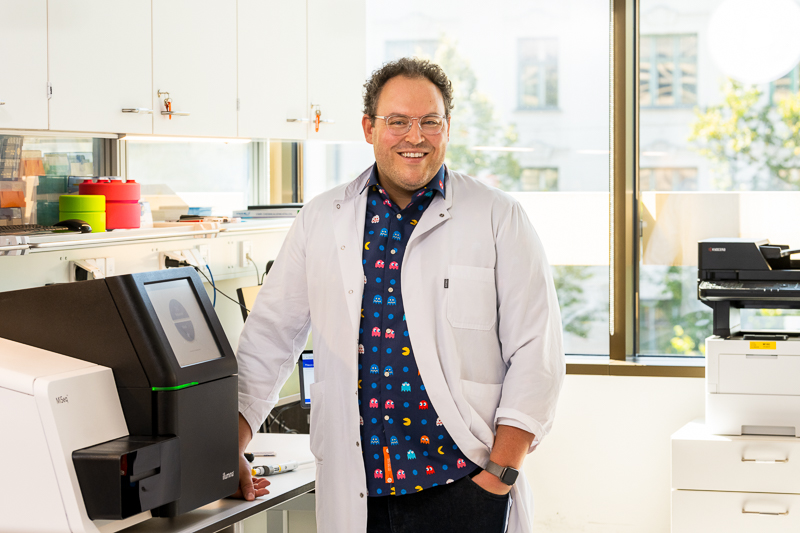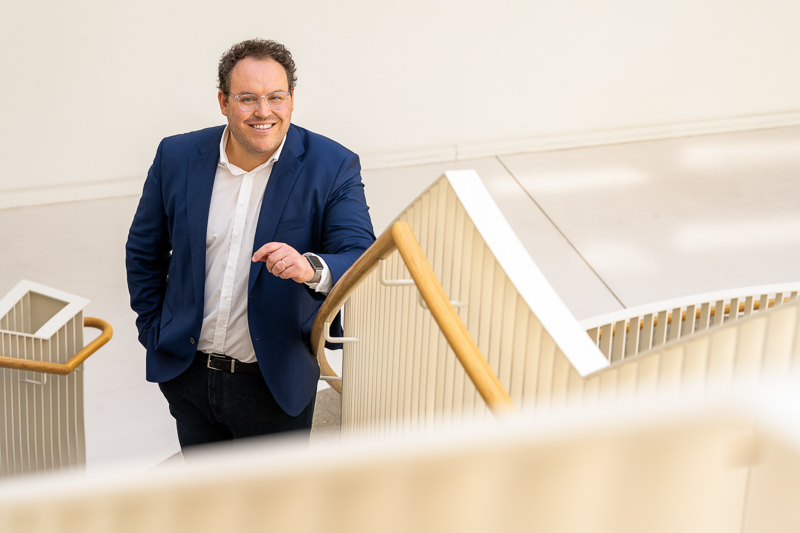)
I wanted to be involved in the development of a new technology.German version/Deutsche Version
Gene editing without double-strand breaks
Base editors had only been invented in 2016/17 by Joung’s colleague David Liu and his post-docs Alexis Komor and Nicole Gaudelli at the Broad Institute in Boston, as an evolution of the CRISPR-Cas technique. CRISPR-Cas systems consist of two parts: An RNA that holds the address of any DNA segment in mirror writing, and, linked to it, a Cas9 enzyme that cuts the double strand of DNA at the exact point it is guided to by that RNA, so that the DNA sequence can be modified there. Although CRISPR-Cas gene scissors can now edit DNA very precisely, they always cut the double helix completely. However, with every double-strand break comes the risk that the subsequent DNA repair mechanisms will not be precise enough, which can produce consequential mutations. Base editors, on the other hand, are three-part systems: In addition to the guide RNA (gRNA) and a Cas enzyme that cuts only one strand of the helix, there is a deaminase coupled to Cas. A deaminase is an enzyme that splits off amino groups and can thus, for example, convert the base cytosine to the base uracil – namely on the uncut helix strand, which the Cas enzyme has exposed by a single cut of the opposite strand. During the subsequent repair of the single strand that was cut, the opposite uracil, which is actually an RNA base, is used as a template and permanently converted to thymine. So this base editor can in fact convert C-G to T-A at a single position on the double strand. Another class of editors can convert A-T into G-C.
An unbiased perspective
At the time Julian Grünewald was struck by the idea of base editors causing undesired RNA effects, he had only spent four months working as a post-doc in Keith Joung’s laboratory. So why did he, of all people, come up with this great but actually obvious idea? “I guess my advantage was that I was looking at things like someone from outside,” Grünewald suggests. After all, he had known little about genome editing before joining the lab and, as a novice in this field, still found himself on a “steep learning curve”. Although he had developed a passion for research during his doctoral thesis and could imagine a future as a physician scientist, he spent the next five years working “quite normally” as an assistant physician in nephrology at the University Hospital of Freiburg. Back then, he was mainly following the advance of CRISPR-Cas through science-oriented articles in popular press. He was also offered a post-doctoral position in Freiburg. “But I am a tinkerer,” says Grünewald. “I wanted to be involved in the development of a new technology that could benefit patients and would have translational potential.” That’s where genome editing seemed to come in handy for him. He became proactive and emailed a series of requests to some excellent labs in the US. For the most part, answers failed to come. So during winter, he embarked on a two-week Ivy League tour along the US East Coast, to introduce himself in person wherever possible. “I never hid the fact that I didn’t know much about gene editing methodically, but I was able to convey my burning passion for the field.” His enthusiasm was requited with polite rejections. Keith Joung, however, was perceptive to the passion that young German doctor had for his field. He sensed how much energy he would be willing to invest. So he hired him. Grünewald remembers: “I was very lucky back then, because I really had no connections at all.” The chemistry between him and Joung has simply been right from the start.
More secure base editors
Keith Joung was impressed by his new collaborator’s “creativity and fearlessness” when Grünewald said he wanted to determine the extent of unwanted RNA editing in cases where APOBEC1 is used for high-throughput sequencing in the transcriptome of human cell cultures. So he gave him a free hand. Even though RNA molecules are, in contrast to DNA, quickly degraded and only present temporarily, non-specific RNA editing had already been described in relation to various diseases. Grünewald went to work and successfully confirmed that base editors, which convert cytosine into uracil at specific positions on the DNA, can in fact unintentionally target and alter tens of thousands of targets on RNA molecules.[i]And he did not leave it at that. In the next step, he constructed base editors with drastically reduced off-target activity and much higher safety by protein-engineering their deaminases.1,[ii] To top off his already astounding work on base editors, he and his team developed base editors which, thanks to a dual deaminase, can transform both cytosine and adenine with high precision and minimal RNA side jumps.[iii]In addition, he designed editors that can convert C-G to G-C on DNA, which represented an even more complicated chemical reaction. Mastering that challenge earned him his first main authorship.4
Shorter ways from ideas to innovation
The atmosphere and teamwork at Joung’s lab were extremely inspiring, says Grünewald, who is in turn praised by his mentor for his great enthusiasm and leadership. Grünewald adds that what fascinated him about Boston were the many smart scientists, and the pipeline between academic research and biotech industry within a manageable ecotope. By that he does not necessarily mean direct collaboration, but a sense of mutual interest that helped realise research results faster, to the benefit of many patients. A good example is the Boston-based company Verve, which recently, only four years after its founding, started the first clinical trial to test base editors for their tolerability and efficacy in the treatment of a certain hereditary lipometabolic disorder. “The fact that you can bring a new technology into clinical trials in such a short time is an incredible and inspiring achievement.”
The CRISPR family’s latest offspring
According to Grünewald, the prime editors developed by Andrew Anzalone and David Liu at Broad Institute in 2019 are “a lot more complex” than CRISPR-Cas gene scissors and base editors. He started researching them back in Boston – and has been continuing that research since February 2022, in a temporary tenure-track professorship at Technical University of Munich (TUM). Prime editors are similar to base editors in that they only cut a single strand of DNA, at the exact position they are sent to by their guide RNA. But unlike base editors, their cas-scissors are not linked to a deaminase, but to a reverse transcriptase (RT). Reverse transcriptases are enzymes that convert RNA to DNA. The RNA they rewrite is carried by prime editors as an appendix to their guide RNA: It is the mirror image of the new DNA segment to be incorporated at the cleavage site. Prime editors can inscribe up to 30 new base letters into a DNA text or remove up to 80 letters from it. “That’s the upper limit,” says Grünewald. “But insertions of up to 10 bases often work well.” His long-term goal is to use prime editors to treat certain heart diseases. And with its excellent set-up for cell and gene therapy, Grünewald says the cardiology department of TU Munich’s “Klinikum Rechts der Isar” is the perfect place for him to achieve this.

The challenge of the heart muscle cell
So far, the liver has been the preferred solid target organ for therapeutic genome editing. The heart muscle, on the other hand, is still uncharted territory, and TUM researchers are doing pioneering work to explore it. “The heart muscle cell is a special challenge,” says Grünewald. Unlike liver cells, which regenerate continuously, heart muscle cells remain the same throughout an entire lifetime, and therefore require the highest integrity at DNA level. In addition, you cannot preserve human heart muscle cells in vitro, which means that their equivalents must be derived from induced pluripotent stem cells. But Grünewald faces this challenge with his ever-characteristic confidence. He plans to address a point mutation on the LMNA gene that causes severe dilated cardiomyopathy, a sort of bulging of the heart that makes it loose more and more of its power. Editing this mutation would be the only way to treat this disease at its root. The alternative would be a heart transplant. “As the new principal investigator here, I have found myself a niche that is both clinically relevant and catering to my engineering interest,” Grünewald says. He was only recently accepted into the DFG’s Emmy Noether Young Investigators Programme. “I am super happy, because now I get to set up my research group in the best possible way.” With its Life Sciences Bridge Award, the Aventis Foundation wants to support him on his way to a permanent professorship.
Author: Joachim Pietzsch, Wissenswort
Photos: © Astrid Eckert
[i] Grünewald, J., Zhou, R., Garcia, S. P., Iyer, S., Lareau, C. A., Aryee, M. J., & Joung, J. K. Transcriptome-wide off-target RNA editing induced by CRISPR-guided DNA base editors. Nature, 569(7756), 433–437 (2019)
[ii] Grünewald, J., Zhou, R., Iyer, S., Lareau, C. A., Garcia, S. P., Aryee, M. J., & Joung, J. K. – CRISPR DNA base editors with reduced RNA off-target and self-editing activities. Nature Biotechnology, 37(9), 1041–1048 (2019)
[iii] Grünewald, J.*, Zhou, R.*, Lareau, C. A., Garcia, S. P., Iyer, S., Aryee, M. J., & Joung, J. K. – A Dual-Deaminase CRISPR Base Editor Enables Concurrent Adenine and Cytosine Editing. Nature Biotechnology. 38(7), 861-864 (2020)
4 Kurt, I. C.*, Zhou, R.*, Iyer, S., Garcia, S. P., Miller, B. R., Langner, L. M., Grünewald, J.# & Joung, J. K.# – CRISPR C-to-G base editors for inducing targeted DNA transversions in human cells. Nature Biotechnology 39(1), 41-46 (2021)